Art Fairs
‘It’s Just Like the Old Days’: Art Basel Opens With Eight-Figure Sales and a Wave of Global Buyers as the Market Looks to Dance ‘Til the Music Stops
The fair returned to its usual summer calendar slot for the first time in three years.
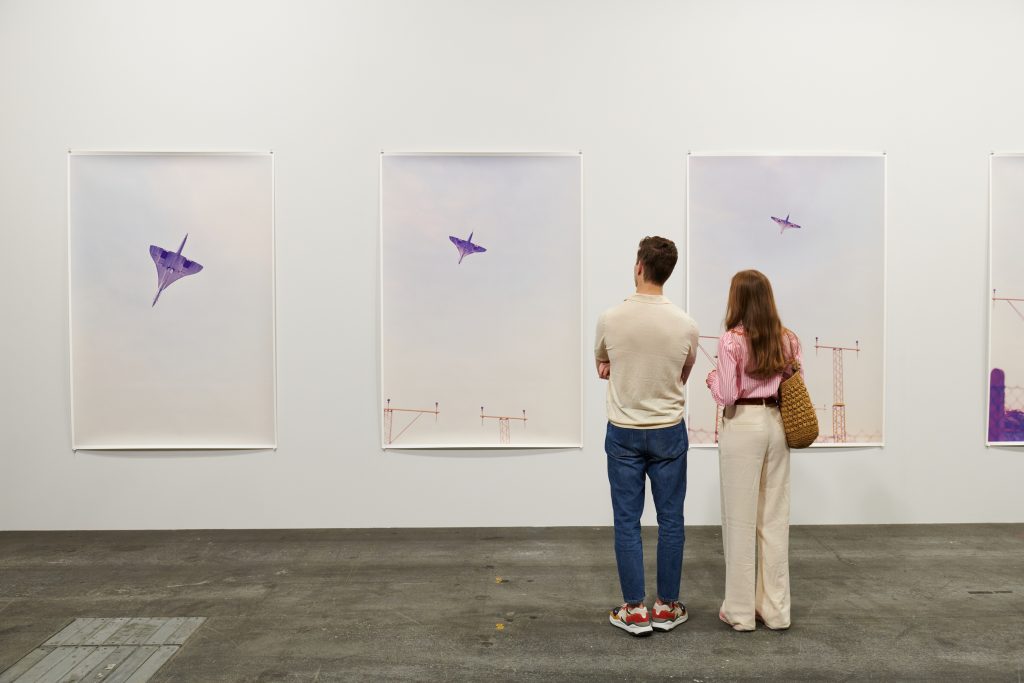
The fair returned to its usual summer calendar slot for the first time in three years.

For those headed to the Swiss city of Basel to attend Europe’s most prestigious art fair, sunburn was a concern. Art Basel is back to its traditional summertime slot in the art-world calendar, running June 16 through 19, and the sun was beating down on the Messeplatz.
With nary a mask or Covid check-in in sight, some toasted the fine weather and a return to normal. Others remained wary, even about the weather, which, as one dealer pointed out on Saturday, might not bode well for sales. “Rain is usually the better retail environment,” she said.
Pre-fair jitters started to melt away as private jets began to clog up Basel airspace and crowds flocked to the Monday afternoon opening of the fair’s Unlimited section, where installations too large for a regular booth are shown in a hanger-like exhibition hall.
Some of that early-bird attendance resulted in commerce: David Zwirner reported the sale of Wolfgang Tillmans’s seven inkjet photographs of a Concorde airliner for $1 million to Norway’s Astrup Fearnley Museum of Modern Art, Galleria Continua sold a Yoan Capote painting for €850,000 ($884,918) to a European institution, and Hauser and Wirth sold Lorna Simpson’s serigraph on felt, Wigs, for $595,000 to a U.S. institution.
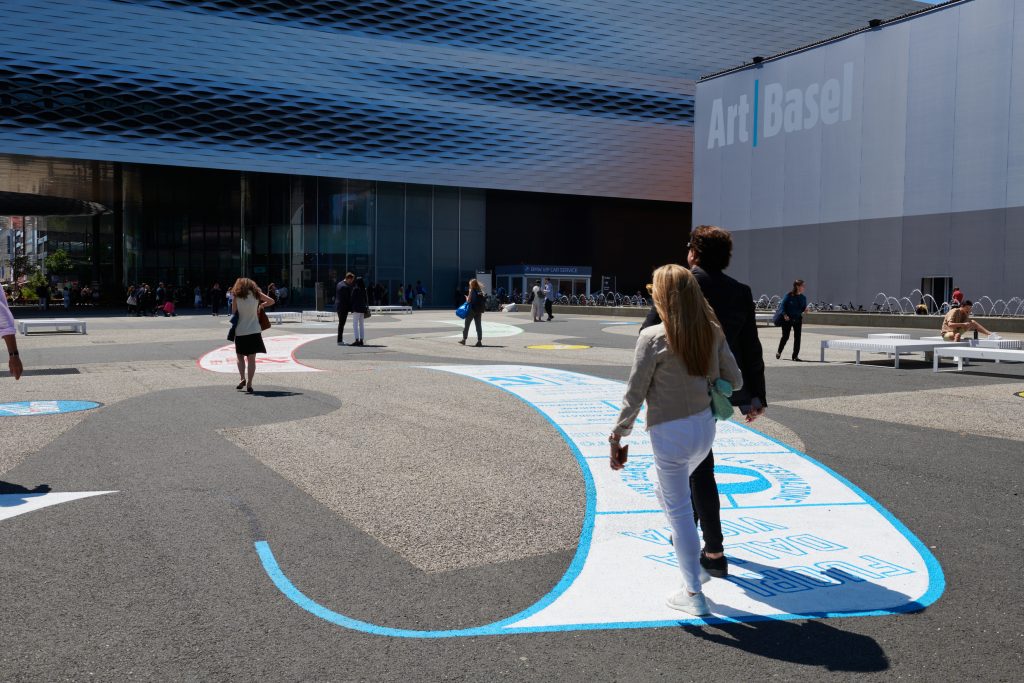
Lawrence Weiner, OUT OF SIGHT. Courtesy Art Basel.
VIPs from Asia and the U.S.—whose absence was felt from the fair’s edition last September—were back in force, with Mera Rubell, Qiao Zhibing, Timothy Tan, and Richard Chang all spotted roaming the aisles of the main event on Tuesday. The atmosphere in the first hour of VIP preview was buzzing: boldface names including Guggenheim director Richard Armstrong, Venice Biennale curator Cecilia Alemani, and collectors Patrizia Sandretto Re Rebaudengo and Uli Sigg brushed shoulders with artist Beeple and Swiss tennis player Roger Federer.
Top line sales filtering in by the afternoon reflected this comeback mood: David Zwirner sold Felix Gonzalez-Torres’s Untitled (Tim Hotel) (1992) for $12.5 million to an Asian collection and Alice Neel’s Elizabeth (1984) for $3.5 million to a U.S. private collection. Elsewhere, Pace sold Adrian Ghenie’s Self-Portrait ‘en plein air’ 3 (2022) for $1.8 million to an American collector and a 1987 Robert Rauschenberg for $1.2 million, while Thaddaeus Ropac sold Georg Baselitz’s X-ray lila (2020) for €1.35 million ($1.4 million).
“It’s just like the old days,” Ropac said. “Americans are back, the Asians are here—it’s what we remember from 2018.”
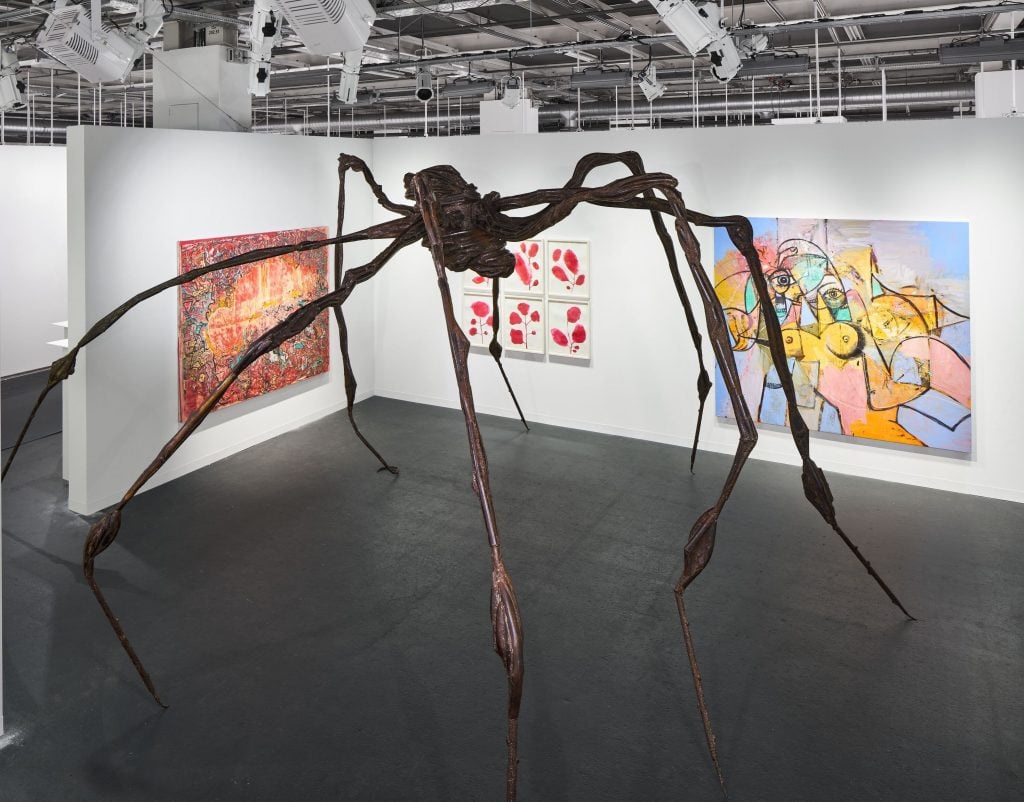
Installation view, Hauser & Wirth at Art Basel 2022, featuring Louise Bourgeois, Spider (1996). © the artists / estates. Courtesy the artists / estates and Hauser & Wirth. Photo: Jon Etter.
But not all was exactly as it once was. Plenty shifted during the pandemic—socially, politically, and, of course, in the art market. Art Basel was an avatar for it all. In an effort to bring in new blood, the fair relaxed its stringent participation requirements, allowing galleries that have been open for less than three years or do not have a physical gallery space to apply. As a result, there were 19 first-timers among the 289 exhibitors, including the Paris and Chicago-based Mariane Ibrahim and Proyectos Ultravioleta from Guatemala City.
Another difference was the crowd at the jam-packed morning reserved for First Choice VIPs, with Hauser and Wirth co-president Marc Payot among those remarking that there were “nearly too many people for a preview.”
“I’m all for democratization when it comes to access to art, but it comes at a cost to conducting efficient business,” art advisor Mattia Pozzoni said. Time was when the riffraff had to find scrappy solutions to blag their way into the exclusive event, he recalled. “People tried to sneak into the fair dressed like janitors or in other clever and cheeky ways, now they don’t need to do that.”
Still, there were notable absences. Some collectors opted to attend non-commercial events like the Venice Biennale and Documenta over Basel, or pass on the fair due to fatigue from this season’s packed calendar. Others still were blocked by Covid-related hurdles.
“I love attending Art Basel but finally decided to skip this year,” California-based collector Mihail Lari said. “The state of the world is so precarious that I’d rather use the $35,000 it would cost just to be there towards other causes that are important to us…such as supporting a Democrat for Congress against a Trump-endorsed incumbent in Palm Springs!”
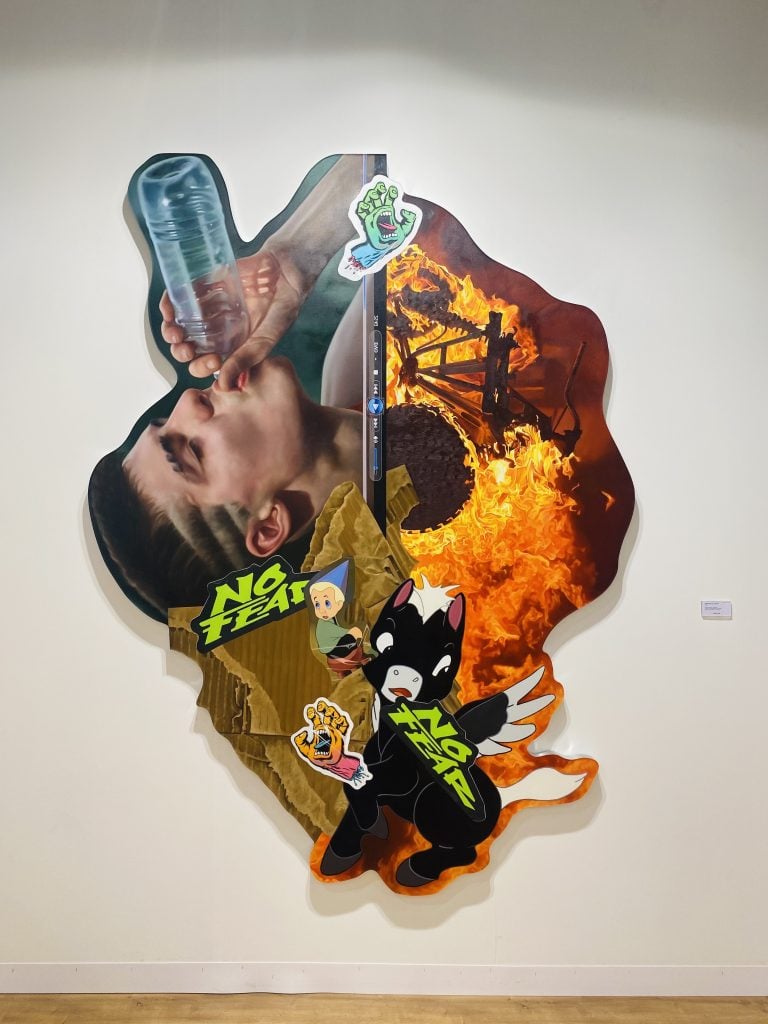
Robin Kid a.k.a The Kid on view at Art Basel. Courtesy Galerie Templon.
Another pandemic shift was the ravenous hunger for work by emerging artists, causing many classically blue-chip galleries to add younger talents to their rosters. This was reflected in the juxtapositions on the ground floor of the fair, which is usually reserved for established, conservative material. Underneath Hauser and Wirth’s towering Bourgeois sculpture, priced at $40 million, were paintings by young stars Rashid Johnson and Avery Singer. At Thaddaeus Ropac, Alvaro Barrington and Rachel Jones faced off with Baselitz and Rauschenberg. At White Cube, it was Cy Twombley and Christina Quarles; at Michael Werner, Sigmar Polke and Florian Krewer.
Early sales reports reflected the speculative energy. Paris-based Templon gallery had no trouble placing works by young artists Robin Kid a.k.a The Kid (€85,000/$88,532) and Omar Ba ($100,000), but buyers were slower to move on more expensive historical works by Jim Dine and Jules Olitski. While Ropac sold its Rachel Jones (£60,000/$71,934), an $8 million Baselitz hadn’t found a buyer by the end of day one.
In terms of market trends, while there remains a lot of interest in figuration, several market players noted change was in the air. “Trends are changing faster than ever, we can see people are turning back towards abstraction now,” Stefan von Bartha said (his gallery sold two works by Imi Knoebel priced at 300,000 CHF/$299,490 and 180,000 CHF/$179,695 on day one).
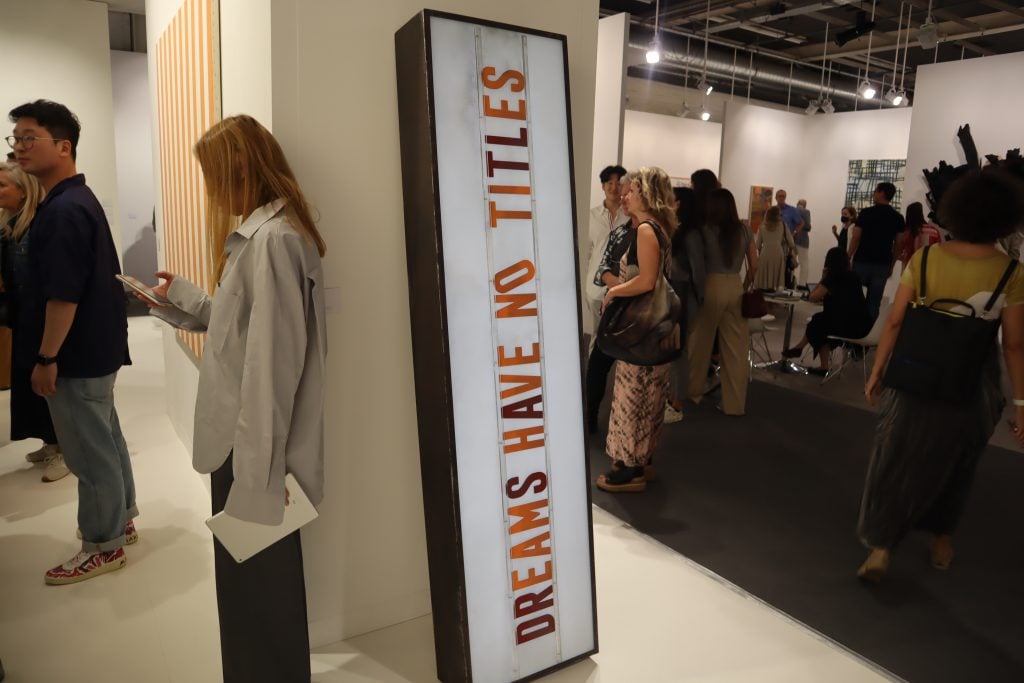
Zineb Sedira at kamel mennour. Photo by Naomi Rea.
Galleries also unsurprisingly cashed in on artists participating in the Venice Biennale, substantiating what has now become a bit of a cliché that you “see it in Venice; buy it in Basel.”
Kamel Mennour sold work by Zineb Sedira, who represented France, and Latifa Echakhch, who represented Switzerland. Examples by artists in Cecilia Alemani’s main exhibition, “The Milk of Dreams,” were also on offer: Pace sold Kiki Kogelnik’s painting Outer Space (1964) to an institution; Lehmann Maupin sold two works by Cecilia Vicuña ($165,000 and $180,000); and Tina Kim gallery was showing a work by Mire Lee ($70,000) in Statements, the fair’s section for emerging art. David Zwirner also sold two works by Marlene Dumas, who has a spectacular retrospective at the Palazzo Grassi in Venice, for $8.5 million and $2.6 million to European collections.
There was a fair amount of grumbling from buyers about the level of pre-selling ahead of the fair. Several dealers and advisors reported that work by hot young market stars all sold from PDF previews as soon as they were sent out; with the hype around these names and their sky-high prices at auction, they could have been sold many times over.
“You used to be able to drink a glass of champagne, buy a work, and create a nice memory. But now, the buying process is horrible,” Pozzoni said. “I’m becoming more cynical by the day. I’m not looking at the aesthetic pleasure of the piece anymore but for its financial return.”
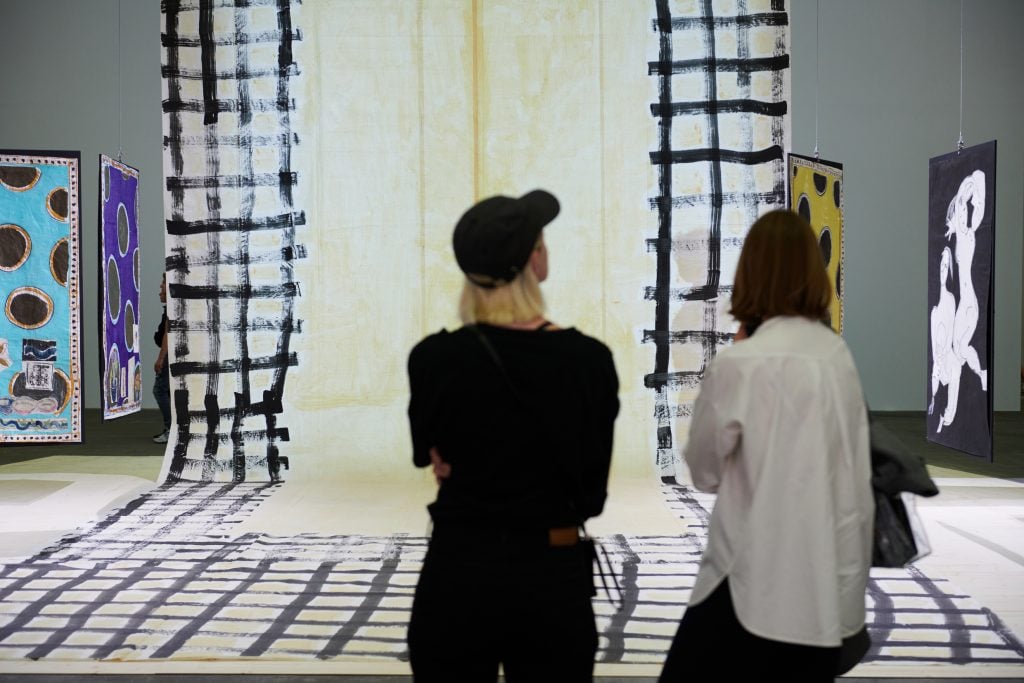
Isabella Ducrot, Galerie Gisela Capitain, Standard Oslo. Courtesy Art Basel.
The quest for a solid investment is not an outrageous proposition given the current economic climate. On Monday, the S&P fell 3.9 percent, and cryptocurrency continued its ongoing crash, with the price of Bitcoin tumbling more than 10 percent at the start of the week. Meanwhile, inflation is accelerating in every corner of the economy, including the art market.
Complaints about too-high prices at the New York fairs were echoed in Basel, and various market players were irked that secondary-market inventory was not fresh enough to market. A work by Michael Armitage popped up at White Cube’s booth three years after it had sold at auction, and a Francis Bacon “Pope” at Helly Nahmad was last traded at Sotheby’s in 2019. It says something about the current level of demand that both of these works sold by the end of day one, but there was something of a dance-until-the-music stops vibe to the whole affair.
Pre-sales and VIP preview activity were strong, but reality may be catching up. “Because the markets are really low, I feel that the big speculative craziness will be over, at least for this week. So there will be a bit less belly-dancing in front of dealers,” art advisor Sibylle Rochat said. “Buying will be a bit more conservative, slow, and thoughtful, and I think it may be a good time to consolidate a collection.”
Having been through the gauntlet of the past few years, some dealers are sanguine. “There’s always something,” said Templon’s Anne-Claudie Coric. “There’s a war in Ukraine, a pandemic, and before that there was the election of Trump. The art market is highly volatile, and those of us who have lived through many crises, know that it stops for a few months but then it picks up again.”